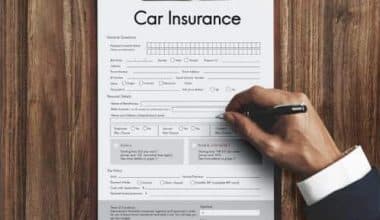When shopping for car insurance, one of the most important decisions you’ll make is whether to choose liability or full coverage (Liability vs. Full Coverage Car Insurance). Liability insurance is the minimum amount of coverage required by law in most states, and it covers the cost of damages to other people’s property and injuries in the event of an accident that is your fault. Full coverage, on the other hand, includes liability insurance plus coverage for your own vehicle, such as collision and comprehensive insurance.
So, which type of coverage is right for you? It depends on your individual needs and budget. Here is a comparison of liability and full coverage car insurance to help you decide.
Liability vs. Full Coverage Car Insurance
What is a Car Insurance Coverage?
Car insurance coverage is an agreement between you and an insurance provider like Progressive, State Farm, or Liberty Mutual. There are one or more coverage categories included in that contract. Every policy has specific terms and conditions that must be met before the insurance provider will pay you or a third party’s medical costs, auto repairs, or other costs.
What is a Liability Car Insurance Coverage?
Your liability insurance covers any harm you inflict on other people. There are two kinds of coverage included:
- Liability for bodily injury covers the damages incurred by the other motorist and passengers. Additionally, it will cover injuries to motorcyclists, runners, bicyclists, pedestrians, and anybody outside of cars.
- If you damage someone else’s property, such as their automobile or the goods inside, including groceries, clothing, a camera, or a smartphone, property damage liability will cover the costs.
What is a Full Car Insurance Coverage?
A policy with both PD and BI liability, as well as two extra coverages—collision and comprehensive—that assist in covering costs associated with vehicle damage, is referred to as having full coverage.
#1. Scuffle
If you are found to be at fault for an accident resulting in damage to your car, collision coverage pays for repairs or replacement.
#2. Encompassing
If a tree branch falls on your car and damages it due to hail, water, fire, or other natural disasters, comprehensive coverage will pay to replace or repair it.
The law does not require collision and comprehensive coverage. On the other hand, your lender might insist that your auto insurance policy include these coverages if you finance your vehicle through a loan or lease. Ensure you have the coverages required to maintain your legal status and fulfil the terms of your loan or lease by consulting with your insurance provider or agent.
#3. Recognising Deductibles and Limitations
Limits for your liability coverages are something you have to select when purchasing a car insurance policy. The maximum sum of money that an insurance company will pay for a claim is the limit. Any expenses that exceed your cap are your responsibility. For instance, if the other driver’s medical claims total $60,000 after an accident and your BI limit is $50,000, you will be liable for the $10,000 difference.
You’ll need to select deductibles if collision and comprehensive coverage are part of your insurance. For instance, your insurance company will reimburse the repair shop $4,000 if your automobile needs repairs and your collision deductible is $1,000. You are in charge of the remaining $1,000.
What Distinguishes Full Coverage Insurance Vs. Liability Insurance?
Here are the distinctions between liability and full coverage insurance.
#1. Protection
Even in cases where you are not at fault, liability-only auto insurance does not pay for damage to your car. If the other motorist is at fault, however, you can file a claim under their liability insurance for damages to your car.
If you have full coverage, your insurance provider will pay for your losses or, if the automobile is totalled, the vehicle’s value is less your deductible.
#2. Cost
Full coverage is more expensive than liability-only insurance since it offers greater protection and coverage.
However, various factors influence insurance premiums, leading to significant household variations in the price of liability vs full coverage. These elements consist of:
- Your age
- ZIP Code
- Sexual orientation.
- Credit Score
- Your driving background and insurance history.
- Insurance provider you use to cover your vehicle.
- The kind and extent of coverage that you select.
- The vehicle’s model and make.
#3. Refundable
Liability insurance claims are paid without requiring you to pay a deductible. However, you do if you submit a collision or comprehensive claim.
For example, in the event of an accident, you will be responsible for paying the first $500 toward auto repairs if you have a $500 collision deductible. You will receive the value of your car less the deductible if your insurance provider totals it.
You will only be required to pay the comprehensive or collision deductible if you submit a claim for liability as well as comprehensive or collision.
#4. Prerequisites
A lender typically demands liability insurance and full coverage when you finance or lease an automobile. Lenders occasionally have requirements regarding maximum deductibles and may want you to carry liability limits over the state minimum.
Liability Vs. Full Coverage Car Insurance: What to Consider
The following five elements are crucial to take into account while choosing between liability and full coverage auto insurance:
#1. Essential Prerequisites
Check the insurance coverage requirements set down by your lender or state. States mandate liability insurance. Lenders demand complete coverage, with certain deductibles required occasionally. However, after you have paid off your car, you may or may not require full coverage, and the amount of your deductible will depend on your needs and preferences. Recall that comprehensive and collision coverage are two different policies. If you don’t need both, you can add just one.
#2. Risk Assessment and Tolerance
A selection of coverage is especially critical if your collision risk is higher. Examine your chances using your:
- History of accidents and claims
- Driving patterns
- Regular routes for driving
- Vulnerability to possible theft
- Causes other than collisions, such as animals, falling trees, floods, or fires
Which would you prefer—taking the chance and paying less upfront for liability insurance or going with full coverage to be safe rather than sorry? You might wish to maintain that coverage if you’ve previously had to submit extensive claims.
Auto insurers charge different prices for full coverage and liability coverage. For complete coverage, your monthly payment will increase—roughly twice as much, on average. However, you’ll have a more excellent defence against unforeseen car damage. Cars that are more expensive, often stolen, or require more costly repairs typically result in higher full-coverage premiums.
#4. Bounds
Your restrictions on liability are up to you. You may raise your liability limits on a full-coverage auto insurance policy to a more significant sum. You cannot select the limit for collision and comprehensive coverage; instead, the amounts are determined by the car’s actual worth.
#5. Car Value
Another factor is the worth of your car. Consider whether the payout, if your car were totaled, would cover the cost of your insurance. Which would you prefer: replacing your automobile without receiving an insurance settlement or paying for repairs out of pocket if it is damaged? For newer, more expensive cars, full coverage is frequently more beneficial.
The Cost of Liability vs. Full Coverage Car Insurance
To calculate your auto insurance quote, carriers examine various rating factors. Your age, gender, driving record, and even credit history are a few examples of them. Your choice of coverage type has a big influence on your premium as well.
If you are found to be at fault in an automobile accident, liability-only insurance will cover any injuries or property damage you may cause up to the policy limits. Complete coverage provides financial security for your car and typically includes collision and comprehensive coverage. Since liability-only auto insurance offers less financial protection than full coverage, it is generally less expensive.
#1. Price Per State
Your state of residence has a significant influence on your auto insurance costs. The cost of automobile insurance coverage is affected by the laws, collision data, crime rates, and cost of living differences specific to each state.
#2. Price According to Gender
Because they are less likely to drive recklessly and file a claim, women typically pay less for full coverage auto insurance. Nevertheless, using gender as a rating element is prohibited in California, Hawaii, Massachusetts, Michigan, North Carolina, and Pennsylvania. Your gender shouldn’t impact your auto insurance cost in these states.
Furthermore, rates could differ more significantly depending on other rating parameters. Given her shorter driving experience, a 24-year-old woman might pay more than a 40-year-old man. Alternatively, a lady in New York City might have to pay more for insurance than a man in a rural Iowan community. Based on statistical data, residing and driving in a densely populated location may increase her risk to her insurance provider.
#3. The Insurance Company’s Cost
Rates will differ amongst auto insurance providers because each has a unique proprietary method of rating policies. It’s usually necessary to search around, compare estimates, and determine what level of coverage is ideal to get the finest auto insurance provider for your needs.
At what point is Full Coverage not Worth it?
For instance, if you keep your car in a garage shielded from animals, falling items, and bad weather, consider removing comprehensive coverage. The next time your car requires significant repairs, you intend to replace it. The value of your car is less than the total coverage deductible.
What is the 50-100-50 Rule for Liability Insurance?
The breakdown of 50/100/50 restrictions is as follows:
- 50 Bodily Injury Coverage: Up to $50,000 in injuries per individual.
- 100 Total Maximum Coverage: $100,000 will be awarded for injuries sustained in each accident.
- 50 Property Damage Coverage: You will be compensated for damages you cause to other people’s property up to $50,000 per accident.
What Does Liability Insurance Cover?
If you are found legally liable for another person’s injury or property damage, liability insurance can assist with paying for both medical and legal costs.
What are the Disadvantages of Liability Insurance?
- Your car is not covered for damage.
- Your medical costs are not compensated.
- Won’t pay expenses that exceed the limit of your liability coverage.
- Might not pay for accident-related legal expenses.






